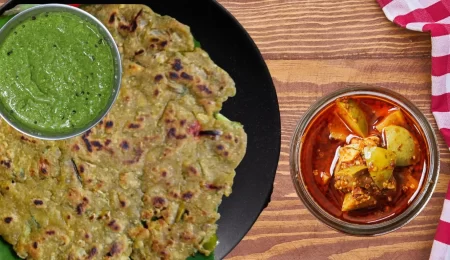Sindhi Tridali Dal
The Sindhi Tridali Dal is a meal that stands out among the rich and varied flavors of Sindhi cuisine. This traditional lentil meal from the Sindhi community is overflowing with flavor and packed with nutrients. We will explain step by step on how to prepare this wonderful dish and what are the best ways to serve it. You and your loved ones will enjoy this awesome meal from Sindhi cuisine.
– Origins of Sindhi Dal
Let’s first explore the recipe before discussing the importance of Sindhi Tridali Dal. Three dals are combined to create the mouthwatering Sindhi Tridali Dal Recipe. The dal gains a deep flavour from a ghee tadka on top. Sindhi Phulkas and Dodas pair best with hot tridali dal that you shouldn’t skip. Also, Sindhi Pakwan goes awesome with Sindhi Tridali dal.
In Sindhi homes, tridali dal has a special position and is frequently cooked for celebrations and family get-togethers. It highlights the best of Sindhi culture and unites people around its unique flavour.
Tidali in Sindhi means “three dals,” as the name implies. Chana dal, urdal dal, and green chilka dal are three different dals that are blended and pressure cooked. Tridali dal gains a lot of flavour from a rich tadka made with ghee, pungent garlic, ginger, cumin seeds, and asafoetida.
All Sindhi households make this tridali dal because it is nutrient- and protein-rich and full of flavor.
– Cooking & Serving
Preparation Time:
30 mins
Cooking Time:
30 mins
Serves:
4 People
– Key Ingredients for Sindhi Dal Pakwan
- Dal:
- 1/2 cup Chana dal (Bengal Gram Dal)
- 1/2 cup Green Moong Dal (Split)
- 1/4 cup White Urad Dal (Split)
- 2 cups water
- Salt – according to taste
- Tadka:
- 1 medium-sized onion, finely chopped
- 2 tomatoes, pureed
- 2 green chilies, slit
- 1 tablespoon ginger-garlic paste
- 1 teaspoon turmeric powder
- 1 teaspoon red chili powder
- 1 teaspoon cumin seeds
- 1 teaspoon mustard seeds
- 1/2 teaspoon asafoetida (hing)
- 1 tablespoon ghee or oil
- Salt to taste
- Fresh coriander leaves for garnishing
– Recipe: Step-by-Step Preparation
- Step 1: Chana, split green moong, and urad dals should all be well rinsed before soaking in water for two hours. Before cooking, drain the water.
- Step 2: The soaked dals should be combined with water, salt, turmeric powder, and a pressure cooker. The dal should be cooked and tender after 4-5 whistles of pressure cooking.
- Step 2: Mildly mash the dals and let the steam escape naturally.
- Step 3: Now lets prepare tadka for dal. Heat ghee or oil in a separate pan. Add the mustard and cumin seeds. Add asafoetida, finely chopped onions, and slit green chilies once they begin to sputter. Onions should be sautéed till golden brown.
- Step 4: Add the minced ginger and garlic, and cook for a minute to get rid of the raw scent. Add the diced tomato now, and heat it until they get well mixed with other ingredients. Salt (to taste) and red chilli powder can be added. Stir thoroughly.
- Step 5: Now add the cooked dal to the masala-filled pan. The flavors will meld if you combine everything and boil it for 5 to 10 minutes on low heat.
- Step 6: Verify the dal’s consistency and make any required adjustments by adding water. It should slowly come to a boil. Turn off the heat when the Sindhi Tridali Dal achieves the appropriate consistency. Garnish with finely chopped fresh coriander leaves.
– Serving
Sindhi Tidali Dal is delicious served with steaming rice or jeera rice. It goes well with hot phulkas as well. Serve with a side of home-made pickle or papad for an added kick. This filling recipe is a complete dinner in and of itself, with a good balance of protein and flavorful spices.
– Tips
- Topping the dal with home prepared tamarind sauce will add to the overall taste.
- Sindhi Papad must go along with the meal.
- And do not forget to have home salad and prepared pickle.
- Avoid black pepper.
– Nutritional Benefits of Sindhi Tridali Dal
- Sindhi Tidali Dal’s Nutritional Value and Health Benefits:
- Sindhi Tidali Dal not only tantalises the taste buds, but it also has various health benefits. Let’s look at the nutritional value and benefits of having this wonderful dal in your diet:
- Protein-dense: Three dals make for a fantastic source of plant-based protein. Protein is required for tissue growth and repair, muscular development, and immune system health.
Good Reads For You
Countryside Grilled Veg Pizza – SindhiZaika.com
The Rural Culinary Experience The countryside is a peaceful place where life is calm and simple. There is no rush and life is full of nature. We enjoy the essence…
Homemade Roasted Butternut Squash Soup: A Fall Classic
Hey there, I am one of those home chefs who loves getting creative in the kitchen, and today, I have got something special for you – Roasted Butternut Squash Soup.…
Healthy and Delicious: The Ultimate Guide to Berry Breakfast Smoothie
How I came to fall in love with smoothies; this is an old story. But I would love to share with you. A few years ago, while I was trying…











Leave a Comment